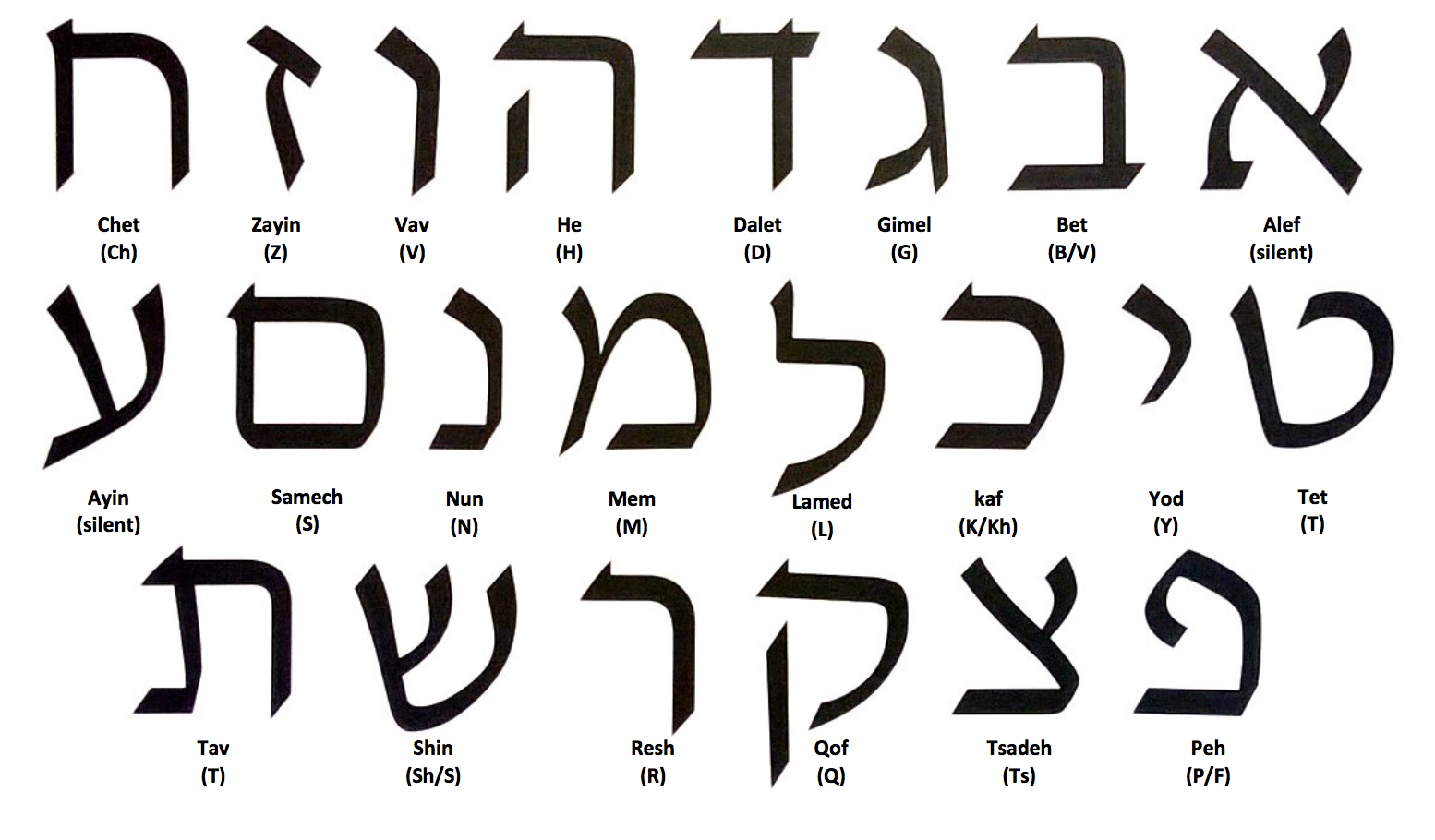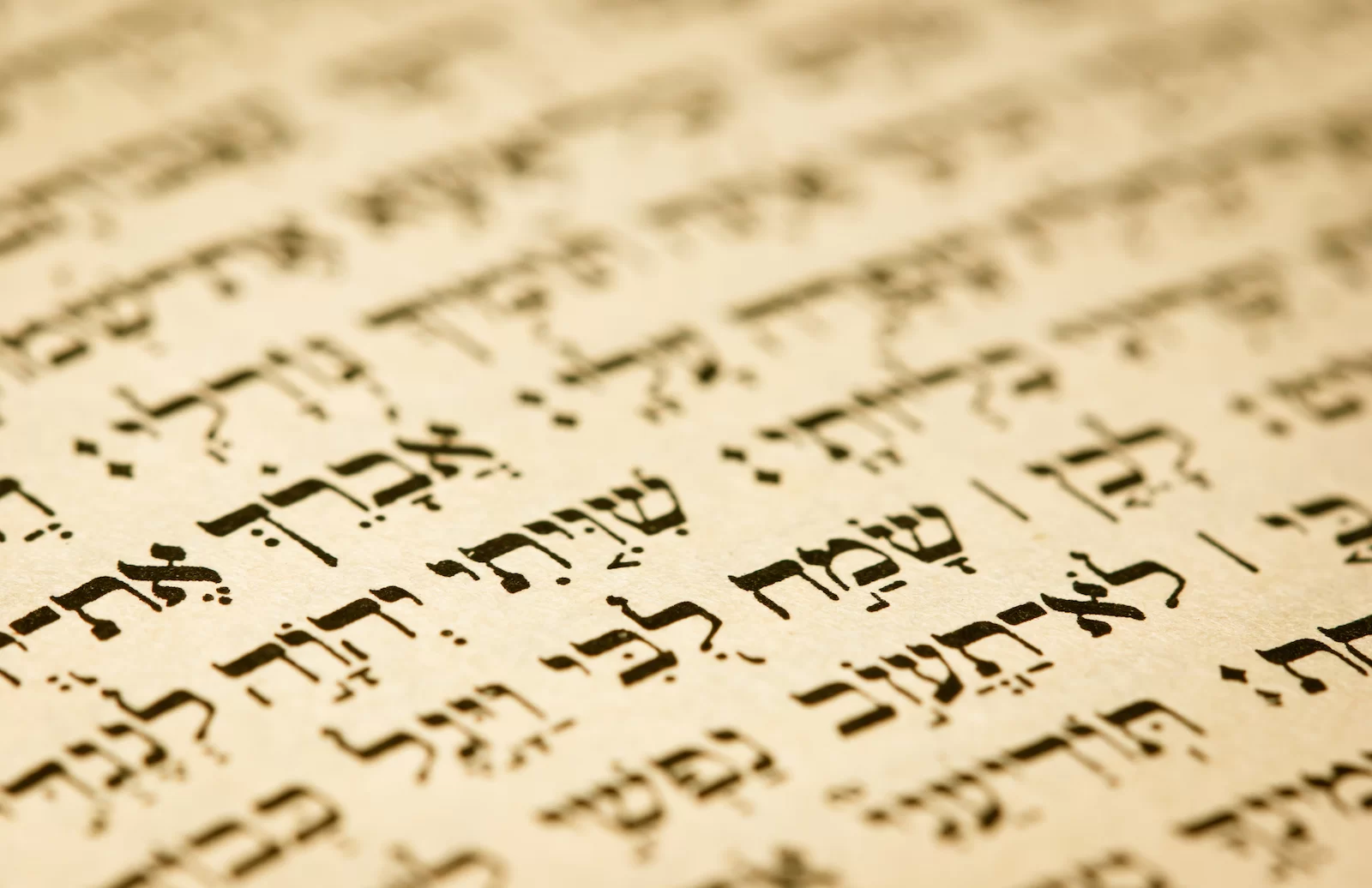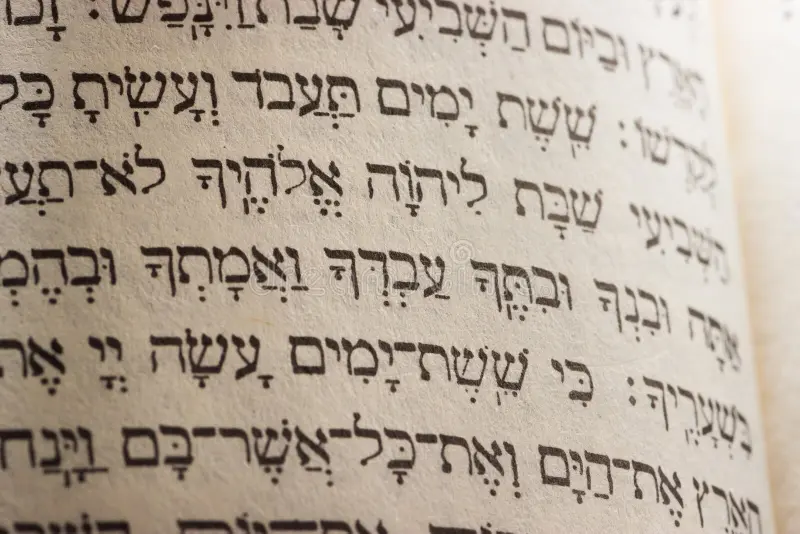The Old Testament Hebrew alphabet has twenty-two consonants. However, the written text did not contain vowels. The vowel point system was invented and inserted during the seventh century A.D. The consonants are written from right to left, reversed horizontally from English writing.
The Alphabet
| Form | Final Form | Represented in translation by | Name | Pronounced as |
| א | ‘ | Aleph | (Glottal stop) | |
| בּ (ב) | b (v) | Beth | B in boy (v in very) | |
| גּ (ג) | g (gh) | Gimel | G in go | |
| דּ (ד) | d (dh) | Daleth | D in day | |
| ה | h | He | H in hat | |
| ו | w (v) | Waw (vav) | W in way | |
| ז | z | Zayin | Z in zeal | |
| ח | h | Heth | Ch in loch | |
| ט | t | Teth | T in toy | |
| י | y | Yodh | Y in yet | |
| כּ (כ) | ך | k (kj) | Kaph | K in keep |
| ל | l | Lamedh | L in let | |
| מ | ם | m | Mem | M in met |
| נ | ן | n | Nun | N in net |
| ס | s | Samekh | S in set | |
| ע | ` | Ayin | (Silent breath) | |
| פּ (פ) | ף | p (ph) | Pe | P in pet (Ph in philos) |
| צ | ץ | ts | Tsadhe | TS in Hists |
| ק | k | Qoph | Q in oblique (k) | |
| ר | r | Resh | R in run | |
| שׂ | s | Sin | S in so | |
| שׁ | sh | Shin | SH in shell | |
| תּ (ת) | t (th) | Taw | T in to (th in think) |
When the student takes the time to correctly learn the name of each letter, he will be able to identify the sound by the initial letter of the name. For example: בּ Beth has the sound of B. ו Waw has the sound of W.
Notes

The Hebrew alphabet has twenty-two consonants because שׂ and שׁ are considered one consonant.
Each consonant is written separately.


There are no specific forms for capital letters.
Certain letters are similar in appearance. Examine the following characters to identify the differences:
| בּ | כּ | פּ | שׂ | שׁ | |
| גּ | נ | ||||
| דּ | ר | ך | |||
| ה | ח | תּ | |||
| ו | ז | ן | |||
| ט | מ | ם | ס | ||
| ע | צ | ץ |
When one of these letters מ כ נ פ צ is the final consonant of a word, it has a different form known as a final form.
The final characters:
| כ | → | ך | נ | → | ן | צ | → | ץ |
| מ | → | ם | פ | → | ף | → |
These six letters כ פ ת ד ב ג, known as the begadkefat, permit two sounds. When written with a dot (called a daghesh lene) in the center, they have a hard pronunciation and are known as “stops.” When the dot is missing, the sound is soft. The letters without the daghesh lene are called “fricatives.”
| Stops | Fricatives | |||
| Voiced | דּ | d | ד th ( in there) | |
| Dental | ||||
| Unvoiced | תּ | t | ת the (in think) | |
| Voiced | בּ | b | ב v | |
| Labials | ||||
| Unvoiced | פּ | p | פ f | |
| Voiced | גּ | g | ג gh | |
| Palatals | ||||
| Unvoiced | כּ | k | כ kh (German Ich) | |
Note. Voiced means that the sound is accompanied by the vibration of the vocal cords, as can be verified by holding a finger on the throat while pronouncing a long th in this; unvoiced means without the vibration of the vocal cords: th in thin is pronounced exactly like the th in this, except for the lack of vibration in the vocal cords.
Note. Stops are explosive sounds that cannot last longer than an instant; fricative can be pronounced as long as one’s breath holds out: contrast p and f.
Other letters:
Aleph is not to be confused with the English “a” or any vowel. It is a glottal stop, a scarcely audible breathing from the lungs. Aleph following a vowel merely lengthens it; at the beginning of a word of syllable is silent; and between vowels is a very brief pause.
Ayin is a guttural consonant that should be pronounced with a slight movement of the uvula (the little fleshly hanging ball in the back of your throat). It is represented in transliteration by the reverse apostrophe.
There is no hyphen that will permit part of a word on one line and part on another. If a word begins on a line, it will be finished on the same line.
Exercises
- Practice writing these letters until accuracy and speed are attained.
- Arrange them promiscuously and practice calling them by name and by the English equivalent.
- Determine the pronunciation of the following letters (begin at the right and go left).
בּראשׁית בּרא אלהים את השׁמים ואת הארץ
והארץ היתה תהו ובהו וחשׁך על פּני תהום
ורוח אלהים מרחפת על פּני המים
ויאמר אלהים יהי אור ויהי אור
- Write in Hebrew characters:
` kh l, `m r, b w `, d v r, h y h, h l kh, y dh ‘, y l dh, y ts `, y sh v, l k h, m wm th, n s `, n the n, ‘ v r, ‘ l h, ‘ m dh, ‘ s h, ts w h, k w m, k r `, r ` h, s y m, sh w v, sh l h, sh m ‘, y kh l, w y` m r, y h w h, ` l, m sh h, w ` l, ` h r n, b ` r ts, m ts r y m, l` m r.